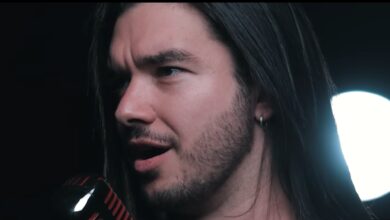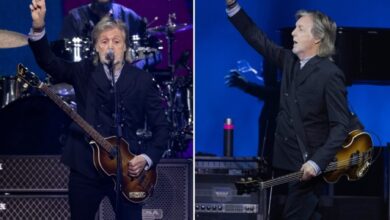Metallica Tore Open Old Wounds with a Devastatingly Intense “One” in Santa Clara 2025
Levi’s Stadium was already roaring when twilight settled over Santa Clara, yet the noise reached another level the moment the giant video cubes flashed a stark black-and-white soldier silhouette announcing “One.” More than 50,000 fans—from kids hoisted onto parents’ shoulders to grey-bearded die-hards who saw the band at Day on the Green four decades earlier—formed a single, vibrating choir ready for six minutes of catharsis.
“One” has always been Metallica’s cinematic conscience: a song born in 1988 from bassist Cliff Burton’s love of Dalton Trumbo’s Johnny Got His Gun, framed by machine-gun tempos and haunted by the thought of a soldier trapped in his own body. The track first shocked mainstream television during the 1989 Grammys, where Metallica lost to Jethro Tull yet still left America stunned by thrash’s emotional range.
For the M72 World Tour, the band rebuilt the live experience around a sprawling, in-the-round stage nicknamed I-Thrash—complete with four drum-tech “towers” and that famous Snake Pit sunk in the center. The two-night concept let them shuffle set lists, but Sunday’s finale felt like a homecoming sermon: sharper, heavier, and packed with Bay-Area inside jokes about “the way to San Jose.”
Earlier in the evening, “Moth Into Flame” lit a fuse that never went out. Then—exactly sixteen songs deep—the lights cut to blackout. A single strobe blinked Morse code across the crowd while hospital beeps echoed through the PA. When the first clean arpeggios rose, everyone knew they’d reached the night’s emotional summit, just ahead of the inevitable climactic sprint into “Enter Sandman.”
The battlefield intro felt even more ominous than usual, perhaps because 2025’s headlines make Cold-War paranoia sound current again; the machine-gun samples landed with a weight that felt freshly relevant, a grim soundtrack for a planet once again flirting with fresh conflict.
Onstage James Hetfield paced like a field commander, ghost-picking the clean guitar passages while Lars Ulrich sat poised to launch the artillery. At the seven-minute mark, Kirk Hammett’s wah-drenched solo soared over Robert Trujillo’s cliff-edge bass, proving that even after forty years the quartet can lock together tighter than military drill—and still find new places to shove a trill.
Fans wedged inside the Snake Pit saw it all from arm’s length, some holding up replica …And Justice for All scales while red tracer-light lasers strafed above their heads. Those beams echoed the 1989 Damaged Justice tour visuals, a nostalgic wink for veterans who caught “One” back when stage pyros first mimicked artillery bursts.
If the sea of smartphones capturing every note felt modern, the sentiments were timeless. A Midwestern fan who flew west for her first Metallica gig wrote afterward that she’d “never heard 50,000 strangers breathe in sync before”—a testament to the way the song’s whispered “darkness imprisoning me” still lands like a collective confession.
The generational blend inside Levi’s proved the band’s credo that heavy music can age without rusting. Grandparents who once spun Ride the Lightning on cassette punched the sky beside teens discovering thrash on TikTok, none of them treating “One” as a museum piece; instead it was a living warning set to galloping triplets.
Hearing that warning in 2025 urged memories of the infamous 1992 Montréal show, when pyrotechnics scorched Hetfield’s arm and forced an abrupt ending. Tonight’s flames were controlled but no less dramatic—every burst timed to the staccato riff that closes the song, a reminder that lessons learned in pain can birth meticulous spectacle.
The lyrics’ vision of mutilated youth felt chillingly topical again, with nuclear tension back in global headlines and veterans in the audience exchanging uneasy glances. As the crowd spat out “Landmine, has taken my sight,” the whirring helicopter samples suddenly sounded less like history and more like tomorrow’s breaking-news crawl.
Technically, Levi’s newly upgraded distributed-audio system banished the echo that plagued rock shows here in 2017. M72’s 360-degree speaker arrays meant even nosebleed seats heard Hammett’s harmonic squeals in studio-level clarity—a small engineering miracle that let the delicate clean tones of “One” ring instead of blur, preserving every ghost-note and harmonic ping.
Offstage, the band’s All Within My Hands Foundation hosted a local food-bank drive all weekend, underscoring that Metallica’s idea of justice now extends beyond lyrical outrage to real-world aid. Volunteer T-shirts reading “Fight Fire with Food” dotted the crowd, weaving charity into the concert narrative more seamlessly than any encore speech.
When the last drum roll faded, the lights snapped to white and the opening riff of “Enter Sandman” crashed in, momentarily turning reflection into release. Giant black-and-yellow beach balls rained down, and some fans almost forgot the war-torn dreamscape they’d just inhabited—which is exactly the bittersweet whiplash Metallica wields so well.
As fireworks stitched bright scars across the Bay-Area night, you could feel 1988 shaking hands with 2025: the same melody, the same warning, a fresh chapter written on every face leaving the stadium. “One” began as a story about isolation, but on this June evening it proved—yet again—that shared noise can be the loudest form of hope.





